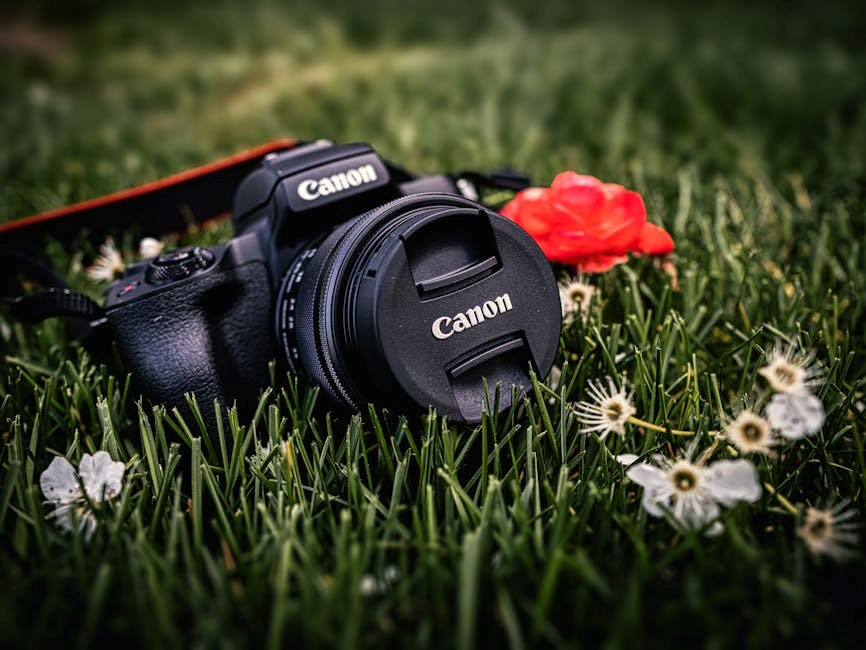The Canon EOS 40D user manual is a comprehensive guide detailing camera features‚ shooting modes‚ and customization options. It helps users master photography techniques and camera settings effectively.
Camera Features
The Canon EOS 40D boasts a 10.1MP APS-C CMOS sensor‚ 9-point AF system‚ 3-inch LCD with Live View‚ and weather-sealed design for enhanced durability and performance.
Image Sensor
The Canon EOS 40D is equipped with a 10.1-megapixel APS-C CMOS sensor‚ offering high-resolution images with excellent detail and color accuracy. This sensor is a significant upgrade from its predecessors‚ such as the 8.2MP sensor in the EOS 20D and 30D‚ providing improved image quality and dynamic range. The APS-C size ensures a 1.6x crop factor‚ which is beneficial for telephoto photography‚ allowing lenses to reach longer effective focal lengths. The CMOS technology minimizes noise and maximizes light sensitivity‚ making it suitable for shooting in various lighting conditions. Additionally‚ the sensor supports DIGIC III image processing‚ which enhances speed and image quality. The EOS 40D’s sensor is also designed to work seamlessly with Canon’s EF-S and EF lenses‚ ensuring compatibility and optimal performance. This advanced sensor technology makes the EOS 40D a powerful tool for both professional and enthusiast photographers‚ delivering crisp and vibrant images consistently.
Autofocus System
The Canon EOS 40D features a highly efficient 9-point autofocus system‚ designed to deliver fast and precise focusing in various shooting conditions. This system includes a central cross-type sensor for enhanced accuracy and sensitivity‚ particularly in low-light environments. The AF points are strategically arranged to cover a wide area of the frame‚ ensuring versatile subject tracking. Users can manually select specific AF points to suit their composition‚ or rely on automatic point selection for convenience. The EOS 40D’s autofocus system is compatible with Canon’s EF and EF-S lenses‚ with improved performance when used with lenses featuring an aperture of f/2.8 or wider. This advanced autofocus capability makes the EOS 40D well-suited for capturing sharp images of moving subjects‚ such as wildlife or sports photography. The system’s speed and reliability ensure that photographers can focus on their creative vision without missing critical moments.
LCD Screen
The Canon EOS 40D is equipped with a 3-inch LCD screen‚ providing a clear and detailed display for image preview‚ menu navigation‚ and settings adjustment. With a resolution of 230‚000 pixels‚ the screen delivers sharp and vibrant visuals‚ making it easy to review photos and videos. The LCD screen supports Live View mode‚ allowing users to compose shots directly on the screen‚ which is particularly useful for precise framing and focusing. The screen’s brightness can be adjusted to suit various lighting conditions‚ ensuring visibility even in bright environments. Additionally‚ the LCD screen features a wide viewing angle‚ making it convenient for sharing images with others. The intuitive menu system on the LCD screen provides quick access to camera settings‚ enabling users to optimize their shooting experience efficiently. This feature-rich display is a key component of the EOS 40D’s user-friendly design‚ enhancing both creativity and productivity for photographers of all skill levels.
Shooting Modes
The Canon EOS 40D offers various shooting modes‚ including Manual‚ Aperture Priority‚ Shutter Priority‚ and automatic settings‚ catering to different photography needs and skill levels for optimal control and ease.
Manual Mode
Manual Mode on the Canon EOS 40D provides full control over camera settings‚ allowing photographers to adjust aperture‚ shutter speed‚ ISO‚ and white balance independently. This mode is ideal for experienced users who want precise control over their shots. By enabling manual operation‚ users can experiment with creative techniques‚ such as long exposures or shallow depth of field‚ to achieve unique effects. The camera’s 9-point AF system and 3-inch LCD screen with Live View mode assist in precise composition and focusing. Manual Mode is particularly useful in challenging lighting conditions or when a specific artistic outcome is desired. It offers flexibility and customization‚ making it a powerful tool for advanced photography. However‚ it requires a good understanding of photography fundamentals‚ as the user must manually balance exposure elements. The EOS 40D’s manual capabilities cater to professionals and enthusiasts seeking ultimate creative control.
Aperture Priority Mode
Aperture Priority Mode (Av) on the Canon EOS 40D allows users to set the desired aperture‚ while the camera automatically adjusts the shutter speed to achieve optimal exposure. This mode is particularly useful for controlling depth of field‚ enabling photographers to isolate subjects or ensure sharpness across the entire frame. By manually selecting the aperture‚ users can create creative effects‚ such as a blurred background for portraits or a sharp landscape with extended depth of field. The EOS 40D’s advanced metering system ensures accurate exposure‚ even in challenging lighting conditions. This mode is ideal for photographers who want to prioritize aperture settings while relying on the camera to handle shutter speed adjustments‚ making it a versatile option for both creative and practical shooting scenarios. Aperture Priority Mode strikes a balance between user control and automatic functionality‚ enhancing the overall photography experience.
Shutter Priority Mode
Shutter Priority Mode (Tv) on the Canon EOS 40D allows users to set the shutter speed manually‚ while the camera automatically adjusts the aperture to maintain proper exposure. This mode is ideal for capturing motion‚ as it enables photographers to freeze fast-moving subjects or create artistic blur effects. By selecting a faster shutter speed‚ users can sharply capture dynamic action‚ while slower speeds can convey motion and create a sense of movement. The EOS 40D’s advanced metering system ensures that the aperture adjustment complements the chosen shutter speed‚ resulting in well-balanced images. This mode is particularly useful in sports‚ wildlife‚ and low-light photography‚ offering creative control over motion and lighting. Shutter Priority Mode provides a flexible balance between user input and automatic adjustment‚ making it a powerful tool for achieving desired visual effects in various shooting scenarios.

Image and Video Settings
The Canon EOS 40D supports RAW and JPEG formats‚ offering flexibility in image quality and compression. It features a 3:2 aspect ratio‚ with a maximum resolution of 3888 x 2592 pixels. White balance settings and ISO adjustments ensure precise control over lighting and noise reduction‚ optimizing image clarity in various conditions.
Still Image Formats
The Canon EOS 40D allows users to capture images in RAW and JPEG formats‚ offering flexibility in image quality and compression. RAW files retain all sensor data‚ enabling extensive post-processing‚ while JPEG files are compressed for smaller file sizes and quick sharing. The camera supports various image sizes‚ including Large (3888 x 2592 pixels)‚ Medium (2816 x 1880 pixels)‚ and Small (1936 x 1288 pixels)‚ all with a 3:2 aspect ratio. The manual explains how to adjust these settings to suit different photography needs‚ ensuring optimal results. Additionally‚ the EOS 40D provides options for fine-tuning compression levels in JPEG mode‚ allowing users to balance file size and quality. This feature is particularly useful for photographers who require high-resolution images for professional work or those who prefer smaller files for casual use. The manual also covers file naming conventions and storage options‚ making it easier to organize and manage your photos.
White Balance
The Canon EOS 40D offers multiple White Balance settings to ensure accurate color representation in various lighting conditions. Options include Auto‚ Daylight‚ Shade‚ Tungsten‚ Fluorescent‚ and Flash. The Auto mode automatically adjusts based on the scene‚ while the presets match common lighting scenarios. For precise control‚ the Custom White Balance feature allows users to manually set the white balance by capturing a reference object under the current lighting. This is particularly useful for achieving natural colors in challenging environments. The manual explains how to access and adjust these settings‚ providing guidance on when to use each mode for optimal results. Properly setting the white balance enhances image quality and reduces the need for post-processing color corrections‚ making it a valuable tool for photographers of all skill levels.
ISO Settings
The Canon EOS 40D allows users to adjust ISO settings to suit various lighting conditions‚ with a range of 100 to 1600. This range can be extended to 3200 using the High or Low settings. The ISO setting determines the camera’s sensitivity to light‚ with lower values (e.g.‚ ISO 100) suitable for bright conditions and higher values (e.g.‚ ISO 1600) for low-light environments. The manual explains how to access and adjust ISO settings‚ either via the camera’s controls or through the LCD menu. Proper ISO adjustment is crucial for achieving optimal image quality‚ as higher ISOs can introduce noise. The guide provides recommendations for balancing ISO with aperture and shutter speed to minimize noise while capturing sharp images. This feature is essential for photographers seeking flexibility in diverse shooting scenarios‚ from portraits to action shots‚ under varying light conditions.

Customization and Advanced Features
The Canon EOS 40D offers custom functions and advanced features‚ allowing users to tailor camera settings to their preferences. The EOS Digital Solution Disk provides software tools for enhanced customization and image management‚ enabling photographers to streamline their workflows and achieve precise control over their camera’s performance.
Custom Functions
The Canon EOS 40D user manual details the camera’s custom functions‚ which allow users to tailor settings to their preferences. These functions enable personalized control over features like autofocus‚ metering modes‚ and button assignments. By adjusting custom functions‚ photographers can optimize the camera’s performance for specific shooting styles or conditions. For example‚ users can customize the AF activation button or set the metering mode to prioritize certain areas. These settings are accessed through the camera’s menu system and provide flexibility for advanced users seeking precise control. The manual guides users in navigating and configuring these functions to enhance their photography experience. Custom functions are a key feature for those looking to streamline their workflow and achieve consistent results. They are particularly useful for professionals or enthusiasts who require tailored camera behavior. The manual ensures that users can fully utilize these advanced customization options effectively.
Auto Exposure Bracketing
The Canon EOS 40D user manual explains how to use Auto Exposure Bracketing (AEB)‚ a feature that captures multiple shots of the same scene at different exposure levels. This is ideal for high-contrast scenes where a single exposure may not capture all details. AEB allows users to select the number of frames (up to 3) and the exposure increment (up to ±2 stops) between each shot. Bracketed images can later be merged using HDR software for enhanced dynamic range. To activate AEB‚ navigate to the camera’s menu‚ select the exposure compensation folder‚ and choose Auto Exposure Bracketing. The manual also provides tips on when to use this feature‚ such as in landscapes or backlit subjects‚ to ensure optimal results. This feature is particularly useful for photographers aiming to capture a wide tonal range in challenging lighting conditions.
Maintenance and Troubleshooting
The Canon EOS 40D user manual provides detailed cleaning instructions for the camera‚ including the LCD screen and image sensor. It also offers troubleshooting tips for common issues.
Cleaning the Camera
Regular cleaning is essential to maintain the Canon EOS 40D’s performance and image quality. The manual provides detailed instructions for cleaning the camera’s exterior‚ LCD screen‚ and image sensor. Use a soft‚ dry cloth to wipe the camera body and avoid harsh chemicals. For the image sensor‚ the manual recommends using a hand blower or Canon-approved cleaning tools to remove dust. The EOS 40D also features sealing materials around the CF card slot and battery compartment to prevent dust and moisture ingress. Always handle the camera with care to minimize dust exposure. If unsure about cleaning the image sensor‚ consult the manual or contact a professional. Proper maintenance ensures optimal functionality and longevity of your camera.
Common Issues
The Canon EOS 40D user manual addresses common issues users may encounter. Error messages‚ such as “Err 99‚” often indicate problems like faulty lenses or memory card issues‚ which can be resolved by resetting the camera or cleaning contacts. The manual also provides solutions for issues like incorrect date/time settings or battery drain. Additionally‚ it guides users on troubleshooting problems related to image quality‚ such as overexposure or blurry images. For sensor cleaning issues‚ the manual recommends using approved tools or consulting a professional. If the camera fails to recognize memory cards‚ formatting or replacing the card is suggested. The manual emphasizes proper handling and maintenance to prevent these issues. Always refer to the troubleshooting section for detailed solutions or contact Canon support for further assistance.

Software and Resources
The Canon EOS 40D comes with the EOS Digital Solution Disk‚ offering software for image management‚ RAW processing‚ and camera settings. Additional resources include downloadable manuals and online support.
EOS Digital Solution
The EOS Digital Solution is a suite of software tools provided with the Canon EOS 40D‚ designed to enhance your photography workflow. It includes Digital Photo Professional for RAW image processing‚ EOS Utility for camera settings and remote shooting‚ and ZoomBrowser EX for image organization and editing. These programs allow you to manage‚ enhance‚ and print your photos effortlessly. The software also supports compatibility with other Canon devices‚ ensuring a seamless experience. Detailed instructions for using these tools are available in the user manual‚ making it easy to get the most out of your camera. This comprehensive software package is essential for both amateur and professional photographers looking to optimize their post-processing tasks. By leveraging these resources‚ users can unlock the full potential of their Canon EOS 40D and achieve high-quality results.
Additional Resources
Beyond the user manual‚ Canon offers various additional resources to help you maximize your EOS 40D experience. The Canon website provides downloadable guides‚ drivers‚ and software updates to keep your camera optimized. Additionally‚ third-party websites offer comprehensive tutorials‚ forums‚ and user communities where photographers share tips and techniques. Online reviews and detailed specifications can also be found to deepen your understanding of the camera’s capabilities. For advanced users‚ specialized guides and workshops are available‚ focusing on specific features like autofocus and custom functions. These resources ensure that both beginners and professionals can continue to learn and improve their photography skills with the EOS 40D.

